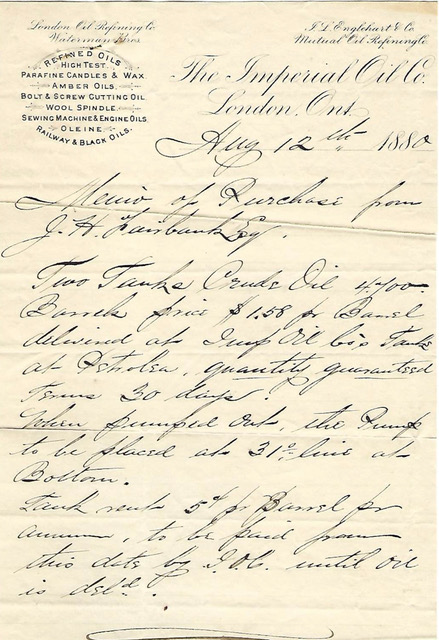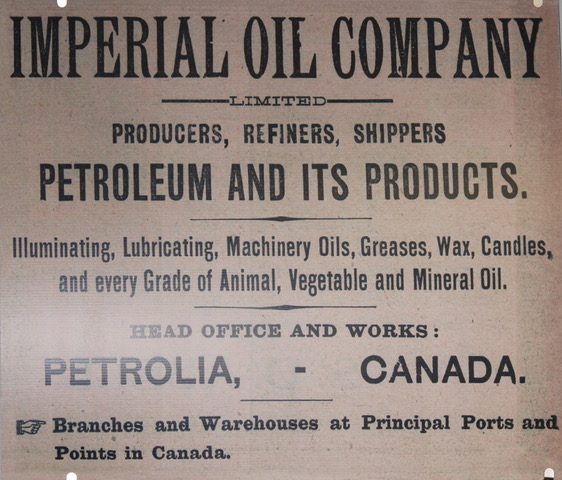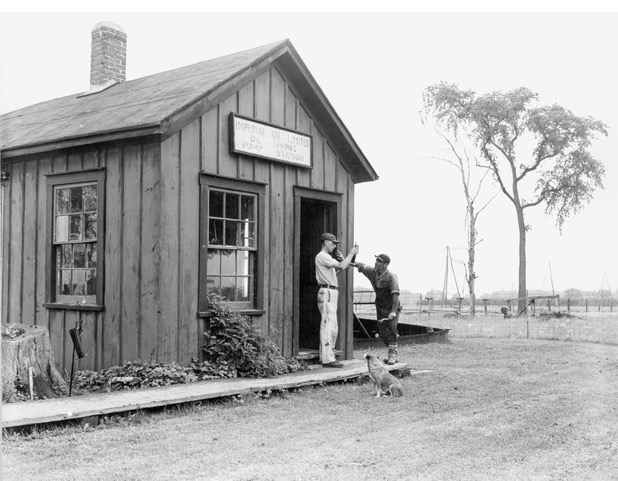Happy 140th anniversary Imperial Oil!
This year, Fairbank Oil is also celebrating a special anniversary. It has been selling its crude to Imperial Oil for refining for 140 years. It is one of the many connections the two companies have shared over the decades. Imperial Oil has deep roots within the county’s Enniskillen Township.
Supplying and Refining Lambton County Crude
Fairbank Oil has been selling its crude oil to Imperial Oil longer than anyone. In the past few decades it has been sending 24,000 barrels of oil each year to the Sarnia refinery.
On April 30, 1880, sixteen oil producers banded together in London, Ontario to form Imperial Oil. Their aim was to keep the all-powerful Standard Oil out of Canada.
We have two preserved memos of purchase showing Imperial Oil receiving oil from John Henry Fairbank in 1880. One shows the date of August 12 and this was before Imperial Oil incorporated that September. The second, dated December 31, shows the changed Imperial Oil letterhead.

John Henry Fairbank received this memo of purchase from Imperial in August 1880, three and a half months after Imperial Oil was first formed in London, Ontario.
Fairbank Family archives.

This memo of purchase sent to John Henry Fairbank is dated December 1880 and shows how Imperial Oil’s letterhead changed after incorporating that September.
Fairbank Family archives
Imperial Oil’s Deep Roots in Petrolia
Imperial Oil had become the lifeblood of Petrolia when it moved its barrel plant to Petrolia in 1883 and its headquarters the next year. Bringing a payroll of $400 a week to the town had a huge impact on Petrolia, for in those days the average man earned a dollar a day.
The Imperial Oil refinery site was formerly Jacob Englehart’s Silver Star Refinery. It grew to a vast 50 acres and it could store 100,000 barrels of crude. In its six major stills, it produced paraffin waxes, lubricating oils, kerosene and greases. It also manufactured Canada’s only 10-gallon cans which were shipped to countries across the Pacific as well as throughout South America.
In 1898 Standard Oil took over Imperial Oil and moved all operations to Sarnia. It was a huge gain for Sarnia and an equal loss for Petrolia.

3) Imperial Oil had all its works and its headquarters in Petrolia, Ontario from 1883 to 1898. This ad was enlarged and hung in the office of VanTuyl and Fairbank Hardware in Petrolia for many decades.
Fairbank Family archives
Fairbank Oil Displays Last Remaining Imperial Oil Receiving Station
Fairbank Oil has Imperial Oil’s very last receiving station that is still standing. The receiving stations were scattered throughout Enniskillen Township for pooling oil before being sent to Imperial Oil. This last receiving station is located at the intersection of Gum Bed Line and Kelly Road in Oil Springs and it is where producers from the Oil Spring area pooled their oil. A team of horse pulling a wooden tank would haul 8-barrel loads to an underground tank, which held up to 100 barrels. Official records were kept at the office inside the receiving station.
In 1886, rail arrived in Oil Springs with a new spur line of Canadian Southern stretching south from Oil City. The pooled oil was transferred to the rail cars and on to Imperial Oil’s refinery in Petrolia and later, to Sarnia.
John Henry Fairbank owned the land of the receiving station and in 1913 he began leasing the one-acre site to Imperial Oil. The agreement lasted for decades but the railway ceased in 1960. Charles Fairbank Sr. (1906-1982) then arranged to keep the station open until 1974 by purchasing the oil from the producers and then selling it to Imperial Oil.
Today, the Imperial Oil receiving station is a stop on the Fairbank Oil Driving Tour and life-sized sculptures of horses and men depict the at work.

4) The Imperial Oil Receiving Station in Oil Springs, shown here in 1849 with Tom Evoy, the receiving station operator talking to Eddie DeKeyser and dog, Mitzi.
Photo courtesy of Imperial Oil Limited, Glenbow Archives, Calgary.
